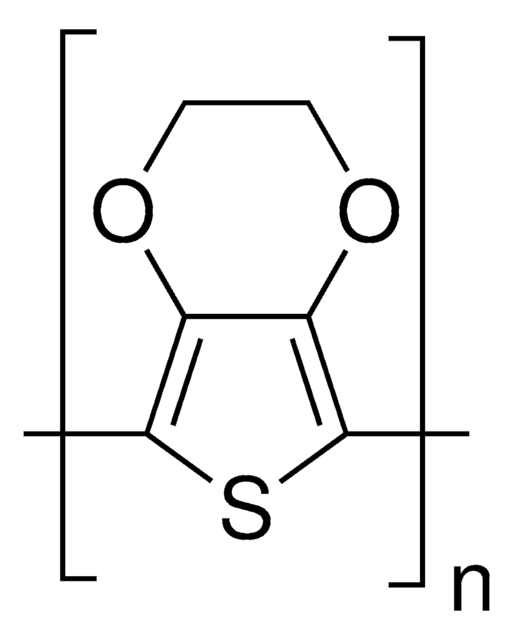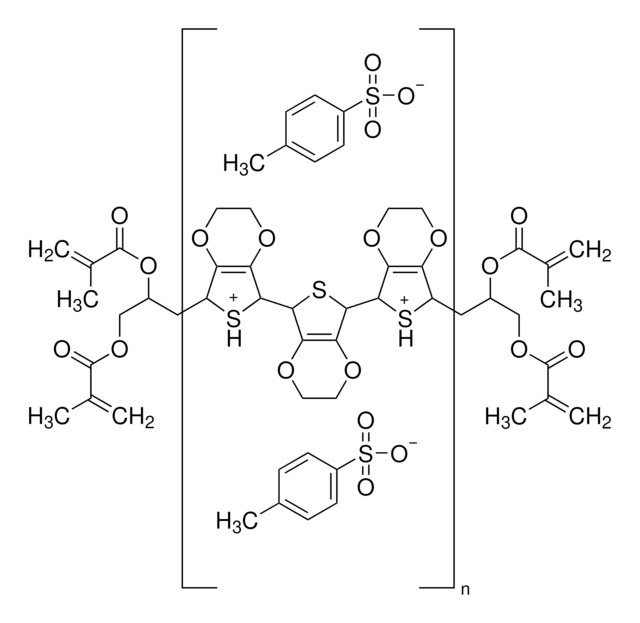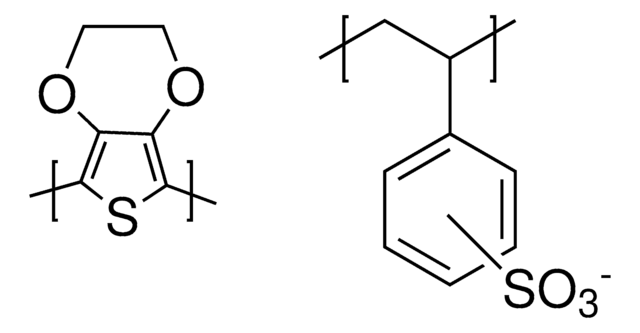736287
PEDOT
bis-PEG, lauryl terminated, 0.8 wt. % (propylene carbonate dispersion), contains perchlorate as dopant
Synonyme(s) :
Aedotron™ C3-NM, C12-PEG-block-PEDOT-block-PEG-C12
About This Item
Produits recommandés
product name
Poly(3,4-ethylenedioxythiophene), bis-poly(ethyleneglycol), lauryl terminated, 0.8 wt. % (dispersion in propylene carbonate), contains perchlorate as dopant
Forme
liquid (dispersion)
Niveau de qualité
Contient
perchlorate as dopant
Composition
acetonitrile, 4-8 wt. %
Aedotron™ TM-C3 polymer, 0.2-0.9 wt. %
propietary processing additive, 0.1-0.7 wt. %
propylene carbonate, 90-95 wt. %
propylene glycol, 0.0-0.3 wt. %
Concentration
0.6-1.1 wt. %
0.8 wt. % (dispersion in propylene carbonate)
Indice de réfraction
n20/D 1.411
Taille des particules
200-600 nm (in suspension)
Conductivité
10-45 S/cm (bulk)
Densité
1.141 g/mL at 25 °C
Vous recherchez des produits similaires ? Visite Guide de comparaison des produits
Catégories apparentées
Description générale
Application
- Printed line width, 120 μm
- Printed line cross-sectional area, 14.1μm2
- Printed line average height, 70.6 ηm
- Sheet resistance, 2.0 kOhms/Square
- Resistivity, 14,021 μOhms·cm (71 S/cm)
- Fairly good optical clarity
Caractéristiques et avantages
Attention
Autres remarques
Informations légales
Mention d'avertissement
Warning
Mentions de danger
Conseils de prudence
Classification des risques
Eye Irrit. 2 - Flam. Liq. 3
Code de la classe de stockage
3 - Flammable liquids
Classe de danger pour l'eau (WGK)
WGK 2
Point d'éclair (°F)
100.0 °F
Point d'éclair (°C)
37.8 °C
Faites votre choix parmi les versions les plus récentes :
Déjà en possession de ce produit ?
Retrouvez la documentation relative aux produits que vous avez récemment achetés dans la Bibliothèque de documents.
Les clients ont également consulté
Articles
Progress in Organic Thermoelectric Materials & Devices including high ZT values of >0.2 at room temperature by p-type (PEDOT:PSS) & n-type (Poly[Kx(Ni-ett)]) materials are discussed.
The application of conducting polymers at the interface with biology is an exciting new trend in organic electronics research.
Optoelectronic devices such as light-emitting diodes (LEDs), solar cells, and light-emitting field effect transistors (FETs) that utilize organic materials as their light harvesting and/or charge transporting component have been the subject of much academic and commercial attention.
Dr. Tan and researcher introduce recent trends in Self-healing Soft Electronic Materials and Devices. The emergence of smart, functional SHPs will be highly beneficial to the advancement of the next-generation self-healing soft electronic devices. Autonomously self-healing devices could help to minimize the need for repair or replacement of electronics and machines, potentially reducing the cost of materials and reducing electronic waste.
Notre équipe de scientifiques dispose d'une expérience dans tous les secteurs de la recherche, notamment en sciences de la vie, science des matériaux, synthèse chimique, chromatographie, analyse et dans de nombreux autres domaines..
Contacter notre Service technique









